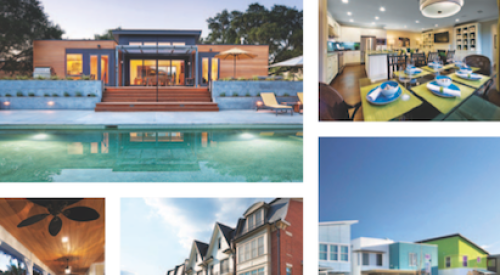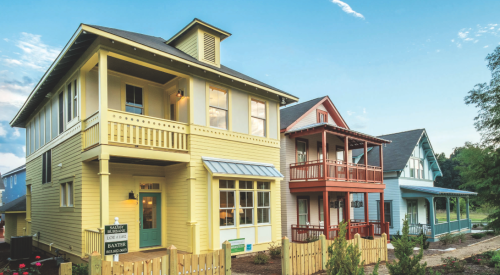|
Loel Fenwick's home is in perfect sync with nature; it almost mirrors a giant tree house.
This captivating home coexists peacefully with the land and animals on the shores of Priest Lake, an undeveloped part of Idaho close to the Canadian border. Fenwick went to painstaking lengths to make sure the home blended seamlessly with the pristine forest and lakeshore of the 400-acre wildlife preserve.
The 11,000-square-foot home comprises three main buildings and functions as a professional retreat center as well as a primary residence for Fenwick, who owns Tanglefoot Master Builders.
Designed by architect James Cutler from Washington state, the home deliberately exposes interior framing, plumbing, conduit and suspension systems. It was designed with tremendous foresight into what Fenwick and his family would feel like living in the forest.
"We wanted a house that was well-integrated into the land," Fenwick says. "Although the house is very large, we wanted it to not be visible as a single mass. We wanted it to be tucked into the trees so that one could go by the house on a boat and not even know that there is a house there at all."
Indeed, it's impossible to see the whole house from just one angle. It stretches out in three main sections to reveal different views of the lake, surrounded by the 8,000-foot Selkirk Mountains. The three main sections as Fenwick calls them:
- The "summer block," including the conference room below and master bedroom above. This section is closed off in the winter when Fenwick and his wife, Olson, move into the main block.
- The "wintergarten" middle section of the house, used as a family gathering place or for retreats. The bridge on the second story connects this glass-walled section to the other two.
- The "main block" with sitting room, kitchen, scullery and pantry on the first floor and a mudroom and the childrens' bedrooms above.


Loel Fenwick's home almost looks like a new building that was built on an old foundation -- the forest floor. "The house is really a piece of structural artwork," Fenwick says. "We wanted to be able to show the beauty of the materials, to be able to show the beauty of concrete and the beauty of beautiful wood."
The home's isolation complements the design. Several tight roads lead to the property, a route that appears to lead to a dead end. Another tiny road leads to the home's garage. But instead of taking that route, Fenwick urges his visitors to get out of their cars and take the 150-foot walkway to the house because it sets the scene.
Details in the Layers"We really wanted to re-explore the basic approaches to the vernacular of construction and see if there were better alternatives to the standard way of building a wood frame house, and covering everything with sheet rock, and hiding all the structural elements, and hiding the utilities within the walls. This house is actually built in layers," Fenwick says.
Fenwick chose fir and larch for the undisguised framing. These two species could handle the structural requirements of the house and were attractive — because they were not being covered, the natural wood had to look good. The wood was sanded, and at least four coats of finish were applied to the lumber before it was cut and after construction.
Each of the four children has a bedroom, bathroom and loft. "Some of those lofts are also in open space so you can be up 30 feet high and look down through this whole space of the house, through all of the halls. I suppose it's like being in a giant birdcage," Fenwick says. There is a removable partition that goes between two bedrooms so four bedrooms can be converted into two large suites in the future when the children move out and come back to visit.
"We love this house. It has so many magical places," he says.
A Tough Sell  Loel Fenwick's home is broken into three blocks: the summer block, the wintergarten block nad the main block. The kitchen is part of the main block and is accessible year-round.  Panels and closets form the closest thing this house has to traditional walls. In many places, framing is visible where it starts at the floor and continues up, disappears momentarily behind drywall panels and emerges again on its way up to the roof. |
The home's distinctive design meant that most standard components didn't fit. Everything from the door handles to locks to the windows are not typical.
Fenwick had the vision, but he never planned on building the home himself.
"Every time we tried to get custom builders to look at it they said, 'This is not the way you do it. You do not build a house this way.' Some of them even doubted that the house could be built, whether it was structurally sound. We had to get some of the best engineers in the country who did an absolutely wonderful job with integrating the architecture with the structural need for the enormous loads we have," he said.
One big challenge that led to Fenwick ultimately taking on the building himself: he was unable to find people experienced in multiple crafts. Some contractors he started working with could not adapt to the out-of-the-box thinking needed to pull off the home's novel design.
In the end, Fenwick wound up using a small number of subcontractors. "We tried, but in the end, we wound up doing it on our own," Fenwick said. He credits his superintendent, Randy Humble, for keeping the work moving along so Fenwick could concentrate on logistics, design and managing relationships between everyone he needed.
Coordinating work with multiple agencies was another formidable task. That included groups such as the Army Corps of Engineers, wildlife agencies, gaming boards, the county and the state.
The extraordinary workmanship, stop-and-starts with contractors, and harsh winters extended construction for 2.5 years until it was finished in summer 2002. All that time, Fenwick had other things on his plate.
Paying HomageFenwick, a former physician, is chairman of a women's healthcare company that develops maternity care services primarily for hospitals. In 1978, he invented the birthing bed and implemented the single-room labor-and-delivery care concept found in many hospitals during the 1980s.
After his success, he went in a new direction and in 1997 started Tanglefoot Master Builders, headquartered in Coolin, Idaho, with a specialty in residential and commercial building. His home was a perfect example of one of Tanglefoot's strengths: executing architecturally significant, technically challenging structures that some people think impossible.
Fenwick hosts retreats on medical care concepts in the wintergarten room and uses breakout space in the adjoining sitting and conference rooms if necessary. Meals for 100 people are no problem because of commercial stainless steel kitchen equipment.
The wintergarten's 28-foot-high, floor-to-ceiling glass and glass ceiling reveal what nature has to offer. A bridge, anchored by cantilever steel beams, that connects the summer block with the main block runs through it. The room slopes into a seating area as it follows the natural contour of the land, almost as if it were a sunken living room.
A 1929 dinghy built for his larger craft was brought into the wintergarten for decoration. Like the house itself, Fenwick considers the boat structural art. It is one of the few such pieces; the family used almost no pictures or ornaments throughout the home.
Healthy BalanceWindows are one of the elements that make the home breathtaking. Mullions on the glass line up with the framing outside so the window's support system is invisible from inside and the glass almost looks as if it's not there. After going through about a dozen possibilities, Fenwick chose glass by Cardinal; it's double-glazed, Low-E and allows enough solar control to warm the house but not overcook it.
At an elevation of 2,400 feet, temperatures vary from as low as 20 below to the low 90s. Fenwick says air conditioning is not needed. In-floor hydronic heating fueled by a propane boiler in the mudroom is installed on the main and upper floors, although the family has found radiant heat has not been necessary upstairs. One wood-burning stove in each block provides enough heat.
Despite its unique approach to building and design, the home is purposely low-tech. It is not loaded with plasma screens or theatre rooms or game rooms. The entertainment is the unspoiled beauty of the land.
"We don't have any TV sets in the bedrooms because we just don't think that's where people should be — not here," Fenwick says. "That's not our lifestyle."
|












